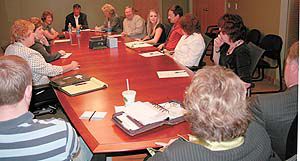| Governor Huntsman sits at the end of the table with representatives from the school district all around him during Friday’s meeting. |
Governor John Huntsman visited Carbon County last Friday to address the state tourism convention at the College of Eastern Utah.
After addressing the conference, the governor spent almost an hour meeting with representatives of Carbon School District at the board of education office.
“I have planned to visit every school district in the state this year and meet with representatives of each,” stated Huntsman. “That means I will be going to all 40 districts in the state. It’s not something I think any governor has done before in one year.”
Huntsman told the group of educators, school board members and one student that he was there to listen to their concerns with an open mind and with an open agenda.
Meeting with the governor were board of education members Grady McEvoy, Debbie Blackburn and Wayne Woodward; Helper Junior High principal Tom Montoya; Joan Atwood from Creekview Elementary; teachers Kathy Railsback, Troy Moynier and Janice Blake; superintendent Patsy Bueno; administrators Judy Mainord and Darin Lancaster; and Carbon High student Angelique Pappas.
“It’s my belief that now that the economy in our state is one of the best in the nation that we should compensate teachers properly,” indicated Huntsman. “That will be my number one concern at the legislature next year.”
The governor said the Utah Legislature has seemed to have a difficult time dealing with the fact that the state now has the money to pay teachers more.
A cultural shift of keeping teachers’ salaries lower in Utah than in the surrounding states is also taking place, added Huntsman.
Teacher compensation in Utah has annually ranked among the lowest in the nation, particularly in the West.
In addition, class sizes in the state continue to rank among the largest.
The governor also told the group that the federal No Child Left Behind mandate seems to be morphing into something different than what it has been largely because local school districts and states have been complaining about some of its more onerous provisions.
| Governor John Huntsman |
“I don’t know where it is going,” said Huntsman. “But I think it will definitely become more flexible in the future.”
However, despite what seem to be some of its shortcomings, Mainord told the governor that she thought the NCLB has been good for the schools in many ways.
Woodward raised the concern about this years funding for teachers, particularly the $2500 extra given for each teaching position.
“Is that something that we should add into the salary base or is it something that is a one time thing?” he asked. “We are afraid that if we add it to our base it will not be funded in the future and then we will be stuck trying to figure out how to finance it.”
Chrisine Kearl, the governors deputy director for education, and who accompanied Huntsman to the meeting told the gathering that the money should be added to the salary schedule, that it is permanent.
“That is how it was intended,” she said.
Other questions asked by the group included concerns about natural resource extraction money that comes back to schools and retention of teachers in rural areas.
The governor said that he couldn’t do much about the federal money from extraction, but said that he was willing to approach SITLA about “tweaking the funding formula for areas that are impacted” by mineral extraction.
As for the retention of teachers, he stated that most people who go through the process of becoming a teacher want to live in an urban environment.
“It is a very real problem,” he said. “Once people have their feet on the ground in education that’s where they want to be.”
He stated he hoped to work on some programs that might encourage teachers to work in rural areas.

